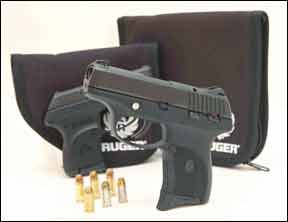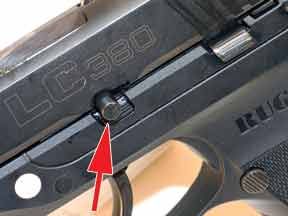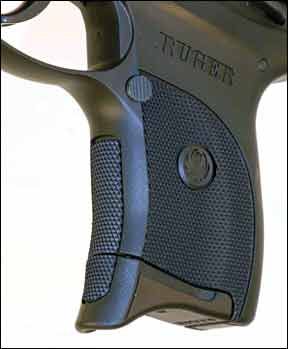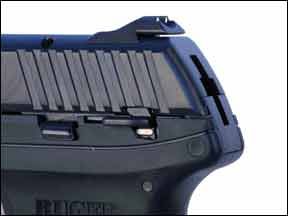Being a magazine that deals primarily with the testing and evaluation of firearms and accessories, were always looking for the next big thing. Not long ago the next big thing was the small concealment pistol chambered for 380 Auto. One such pistol was the Ruger LCP380, and it seemed like every maker was bringing out a small pistol with barrel lengths shorter than 3 inches and an overall size that could fit inside the dimensions of the average adults hand.

One of the things that worked against these guns was the lack of availability of ammunition. Call it 9mm Browning, 9mm Corto, 9mm Kurz – in English, 9mm Short – 380 ACP ammunition was difficult to find. Another factor that seemed to cool enthusiasm for the little 380s was handling and recoil. While 380 Auto is not a big banger, when housed in a smaller package with limited grip space, every impulse was magnified. In addition, a lot of buyers have found these smaller guns with their necessarily taut recoil springs to be unappealing simply because they have trouble manipulating the slide.
In the meantime, Ruger introduced a new pistol of similar design to the LCP, but slightly bigger, chambered for 9mm Luger, 9×19 or 9mm Parabellum, or regular-sized 9mm ammunition. This pistol was a lot easier to hold and work than the still-smaller 380 pocket guns, but the bigger powder payload also offered additional recoil. Solution: For 2013, Ruger introduced the LC9 re-chambered for 380 Auto, which addresses both the desire for less recoil and easier handling, and we were able to land one for evaluation. So that we could hurry the test into print, we didnt try to match it up against other 9mms, but rather relied on previous test notes to put the little Ruger into perspective.

Maybe were lucky or just persistent, but we were able to find boxes of 380 ACP here and there at a variety of different big-box stores. Test ammunition included 102-grain Remington HD BJHP, 90-grain Federal Premium Hydra-Shok JHP, and 92-grain FMJ rounds from Sellier & Bellot. Our test distance for our accuracy session was 15 yards, and to shoot the LC9, we used the adjustable-height pistol component from Caldwells Matrix system, which is a modular shooting rest. For accuracy data we collected five-shot groups with the bullet holes measured center to center. To keep track of our hits, we employed rigid plastic-coated targets from Caldwellss Tip Top selection. They are waterproof and are also sized and perforated for saving in a loose-leaf binder.
In addition to our benchrest session, we also performed an action test. This consisted of timed fire standing offhand at the 7-yard line. Using a Competition Electronics CED8000 shot-recording timer, we fired three shots at a circular paper target, 6 inches in diameter. During our bench session, we noted that the trigger pull was quite long. We wanted to know if the trigger pull was going to have a negative effect on our ability to deliver accurate hits in rapid-fire mode. Start position was with the gun held in both hands, elbows bent so that the gun was close to the body, but we could see the front sight in our peripheral vision as we faced the target. After a practice round of five three-shot runs, we recorded five consecutive strings of fire. We marked down how long it took to fire the first shot and the total elapsed time after the third shot was fired. Naturally, we kept track of our accuracy. Not only were we looking for the fastest times, we also wanted to see if our times would steadily improve. If the results from this test did not indicate consistent improvement, this might be an indication that the gun was difficult to learn or was simply unforgiving.

Notes from our shooting session showed that hits from our LC380 were landing about 1.5 inches high on our 15-yard targets. But we found the size of the gun to be very suitable. The only cautionary point we could pass along was that when fired from support, we had to consciously make an effort not to let the edge of our trigger finger drag against the lower interior surface of the trigger guard. But when fired offhand without the pressure of support beneath the frame, we were able to seat the gun lower inside our grip and obtain a clean purchase of the trigger. We found the left-side-only thumb-operated safety to be pleasingly stiff and sure in operation when turning the gun on and off. One additional safety feature was the fact that the LC380 will not fire without a magazine in place.
The sight picture was quite clear, making good use of its 4.5-inch-long sight radius. Sight radius was maximized thanks to the rear unit seated to match the profile of the rear face of the slide, minus consideration to continue its forward-leaning contour. The steel sights offered a three-dot picture with both units dovetailed into place. The top of the slide was fitted with a loaded-chamber indicator that angled upward when a round was in place. Given the slide was black and the indicator was a contrasting stainless steel, the shooter could see or feel the guns status by running a finger across the top of the LC380.
It might be easy to assume that all plastic-looking pistols are made from polymer. But Rugers choice of synthetic material is actually high-performance glass-filled nylon, which lends itself well to producing an effective grip pattern. There were separate panels of molded checkering on the sides of the grip, the front strap and also the rear of the grip. Together, the checkering design produced a handsome appearance as well as meaningful traction. The lower forward portion of the grip was inlet, producing a set of graceful lines. With the alternate basepad in place to extend the grip, we could better accommodate the pinky finger on the LC380.

Takedown of the LC380 required a push tool referred to as a key, which was supplied. Once lost, a 5/64-inch Allen wrench would suffice. To begin removal of the top end, the first step was to slide down the panel (referred to as the takedown plate) that blocked the takedown pin from drifting astray. With the slide moved rearward and held about 1/16 inch open, the key could be used to push out the takedown pin from the right-hand side of the frame. With the slide removed, we found a polymer guide rod surrounded by two recoil springs. One spring fit over the other with the coils crisscrossing in opposite directions.
The interior of the LC380 magazine was fit with extra material against the rear inner wall to make up for the shorter cartridges. This is not unusual and resembled the interior of 40 S&W caliber magazines that are made for use in single-stack 1911 pistols. Checking with a Ruger customer service representative, we learned that the LC380 magazines were adapted from the LC9 pistol.
From the bench the Ruger LC380 delivered five-shot groups that measured about 1.8 inches in width for every type of ammunition we tried. The LC380 was completely reliable and fun to shoot. The grip was easily held, and the trigger responded evenly.
In our action tests, our first three shots in the practice session took about 2.24 seconds to complete. When we began our shots of record just four strings later, our first three shots were completed in just 1.86 seconds. The timer showed a first shot was fired 0.91 seconds after the start signal. Our second string of fire took 1.95 seconds. The first shot came at the 1.09-second mark. From then on, elapsed times shrank consistently. Strings number three, four, and five lasted 1.78 seconds, 1.70 seconds and 1.55 seconds, respectively. The elapsed time to first shot shrank from 0.94 seconds to 0.89 seconds and finally to 0.80 seconds. Accuracy for our five strings of fire produced 9 of 15 shots inside the 6-inch-diameter circle. Three shots just barely missed the circle, one of which was high and two were low. The remaining shots were more than 1 inch low, but were nevertheless in line with the center of the target.
Our Team Said: The supplied gun rug was good looking and useful, but we would rather have had a second magazine even if the cost of the complete package was increased. Perhaps availability is a greater issue than offering the pistol at the lowest possible price. The magazine extension looked great, but wasnt really necessary, in our view. If the basepad were to increase capacity along with length, that would make it more appealing. But changing out the basepad showed us that the magazine was easy to take apart and put back together – meaning there is no reason to shy away from cleaning the magazine interior on occasion, or, if necessary, changing out the spring. Rugers LC380 is an affordable 380 ACP pistol offering better ergonomics than the smallest pocket 380s and a more-pleasant shooting experience than most 9mm Luger-chambered small carry guns.
Written and photographed by Roger Eckstine, using evaluations from Gun Tests team testers. GT































